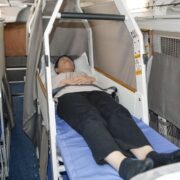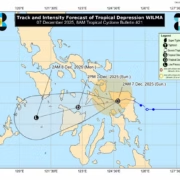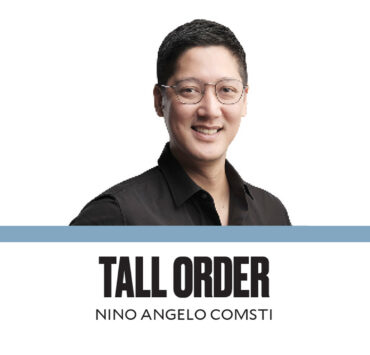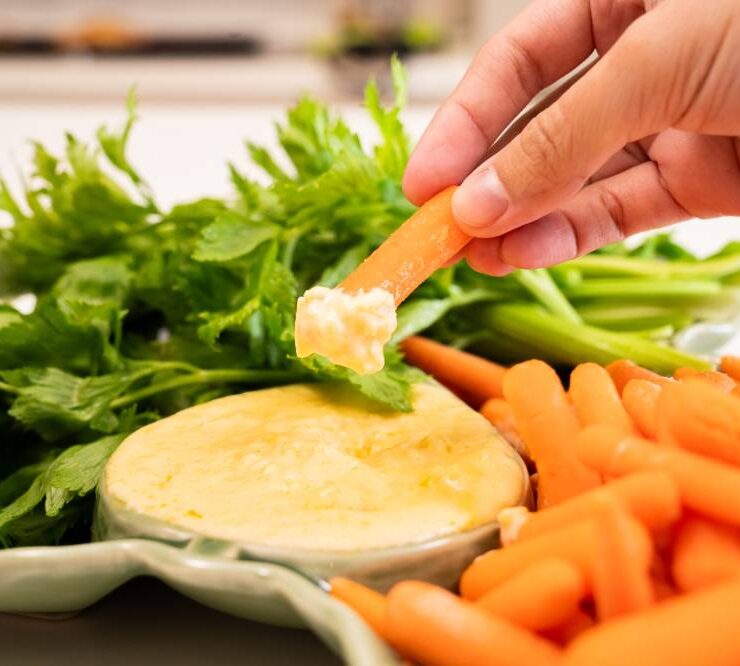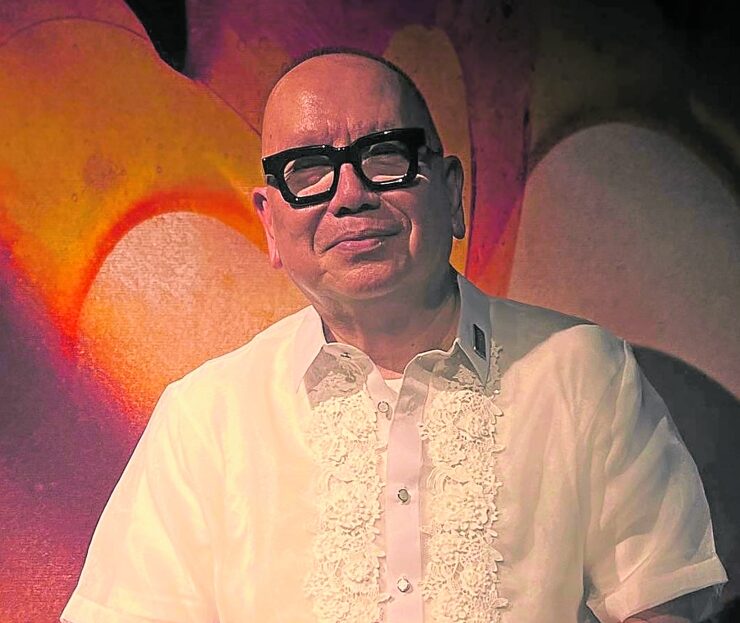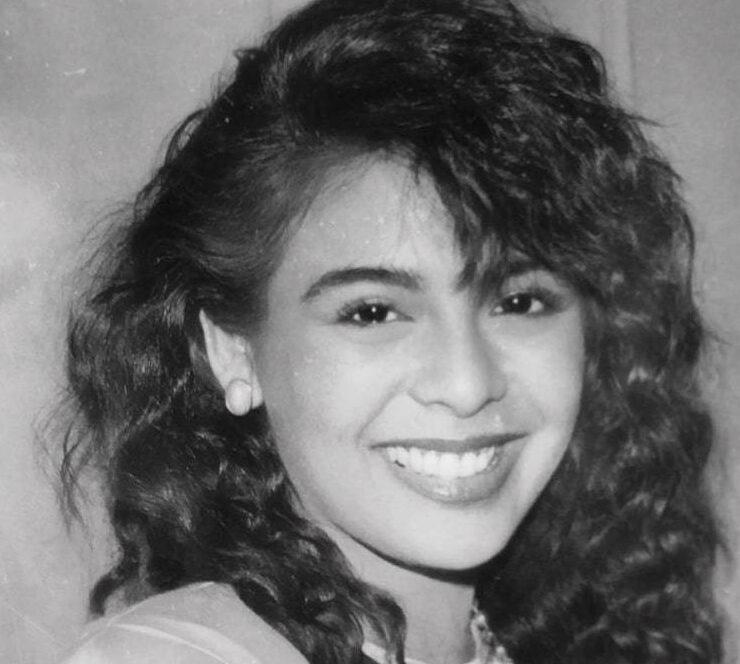Chef Nobu taught me how to make sushi

Chef Nobu Matsuhisa wanted clean hands.
This was something the legendary chef stressed to Charisse Chuidian, vice president of public relations at City of Dreams Manila. “Did you tell them to wash their hands?” he asked her more than once.
And this was something he stressed to us, a bunch of food-loving journalists, the lucky participants in his sushi class at Nobu Manila.
Nobu Manila, Nobu Hotel, and City of Dreams are all celebrating their 10th anniversary this year and Matsuhisa was here, on his first visit since 2019, to join the festivities.
Fans of Matsuhisa and his food got two chances to meet the chef at Nobu Manila last week, at the Art of Omakase dinner event on March 25 and Canapé Night on March 26.

“What excites me most is the opportunity to connect with our guests, to see their reactions as they enjoy each dish. It is not just about the food, it is also about sharing stories and creating memories,” Matsuhisa told Lifestyle.
We got to create memories with Matsuhisa—but first, some serious hand-washing. Clean hands were essential because Matsuhisa does not believe in using gloves. In Japan, sushi is traditionally prepared with bare hands.
“In the States, in New York, chefs have to be gloved. But with clean hands, we don’t need gloves,” he said. “Sushi is made with 10 fingers, and people take their sushi with their hands—hand to hand, heart to heart, this is my way. That’s why I asked you to wash your hands.”

Signature dishes
The demo began with Matsuhisa showing us how to make three of his signature dishes: Yellowtail Sashimi with Jalapeño, Nobu New-Style Salmon Sashimi, and Baby Spinach with Dry Miso. (Another signature dish you shouldn’t miss when you eat at Nobu? The Black Cod Miso. It’s a masterpiece.)
People like asking him what his next dish will be, Matsuhisa shared. “Usually, I never think about what’s next.”
Instead, he finds inspiration when he travels, when he visits markets and sees produce, and when he interacts with guests. “That’s the moment I create.”
For example, his Yellowtail Sashimi with Jalapeño was a dish he created in Maui, Hawaii. Matsuhisa and other chefs from different parts of the world had cooked for a big charity event and when it was winding down, it was their turn to eat. They all whipped up something for their fellow chefs, and Matsuhisa wanted to do something simple.
He spotted jalapeños and cilantro in the fridge. Cilantro isn’t used in traditional Japanese cooking, but that didn’t stop him.
He sliced some leftover yellowtail thinly, topped it with jalapeño, garlic paste, yuzu soy sauce, and cilantro. No wasabi for this sashimi—the jalapeño takes its place. Everyone liked it.

Back in Los Angeles, a customer asked him for something different, so he served that dish. The customer liked it. He started making it every day, and now it continues to be a popular dish on Nobu’s menu.
He calls it “Nobu Style.” “Nobu Style is always looking for something new, something interesting, something great, good taste.”
Another example? His popular New Style Sashimi—a dish he created after a customer complained that she couldn’t eat raw fish. Not wanting to throw out perfectly good fish, he poured hot olive oil over it, essentially searing it, before sending it back to the table. “She took a bite, two bites, and finally, she ate it all.”
Matsuhisa and his chefs demonstrated how to make the dish. “Please be quiet so you can hear the sounds,” he said, wanting to make sure we listened to the salmon sizzle as the mixture of olive oil and sesame oil hit the plate.
The thinly sliced sashimi sat in a mixture of the oils and yuzu soy sauce and was topped with garlic purée, sliced ginger, chives, and sesame seeds. It was absolutely delicious. “It’s a good way to start eating sashimi,” said Matsuhisa.
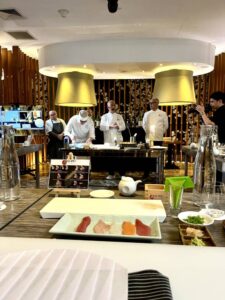
Fish, wasabi, rice
Soon, it was time to learn how to make sushi. “Sushi is very simple: fish, wasabi, rice. But how many grams of fish? How much wasabi? And how much sushi rice?” said Matsuhisa.
It’s all about balance, he said. “Sushi is very simple but very delicate in all the details.”
The quality of fish is very important. “But sushi rice is even more important,” the chef said, showing us how to cut the rice with rice vinegar.
“Cut, not mix,” he said, as he expertly worked the rice inside the hangiri.
Sushi rice has to be body temperature. “Not too cold, not too hot.”
And use every grain, he said. “I don’t want to waste any piece of rice. Even one piece of rice takes a year for a farmer to grow. We have to use all the pieces of rice—respect to the farmer. People are talking about sustainability. But my concept since the beginning is never waste, use all.”
Matsuhisa believes that “sushi is about feeling… Every sushi chef makes it a different way. I’d like to show you my way. My mentor, 50 years ago, taught me this way.”
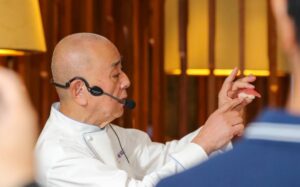
He demonstrated the six-step process, first with a little tube of rolled up paper that we all had on our tables, asking us to mimic him.
Matsuhisa’s hands and fingers moved deftly while mine struggled, like a terrible dancer who couldn’t keep up with the steps.
He did it again, this time with actual ingredients. Push, cup, roll, press, touch. Matsuhisa’s expert hands made it look so easy.
But when it was my turn, disaster. I wet my hands, grabbed the beautiful slice of tuna, put it on my left palm, swiped a little bit of wasabi onto it, and then, using my right hand, grabbed a ball of rice from the bowl. My attempt to shape it failed. Instead, grains of rice covered my entire hand, a sticky, sticky mess.
Nobu Manila’s chefs were at our stations, offering assistance. Jun showed me that I had taken too much rice and that my hand had not been wet enough.
I tried again and again, getting slightly—only slightly—better at shaping the rice.
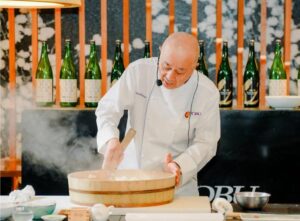
In front, Matsuhisa repeated the demo, before going to every station, patiently teaching each participant the six steps. “Hold it this way.” “No, do this.” “Not like that.”
“Practice, practice, practice,” he said.
He smiled and said, “Now you have respect for the chef, right?”
Absolutely. I have a much deeper appreciation for sushi chefs now.
“I told you, sushi is very simple but most important is heart,” Matsuhisa said. “If you make sushi and give it to somebody—your husband or wife or family or boyfriend or girlfriend—put everything into it. Between the six steps, put your heart in your piece of sushi–this is most important.”
I asked how long it took Jun to learn how to make sushi. “Two years,” he said. I felt a little better about not figuring it out in one session.
Spicy tuna hand roll
I had better luck with the spicy tuna hand roll. For this one, my left hand had to be dry to keep the seaweed crisp. My right hand grabbed some rice—twice the amount used for nigiri, said Matsuhisa—and copying the chef’s pulling and pushing action, worked the rice so it would lay flat on the seaweed. I put the tuna in the middle, sprinkled it with scallions, added the creamy spicy sauce, and rolled the seaweed, sealing it with the extra thin strip of seaweed.
“Customers have to eat this immediately so the seaweed is still crispy,” said Matsuhisa, taking a bite of the spicy tuna hand roll he just created.
I did the same with my hand roll. It was extra delicious—it tasted like success.
We had one more lesson left.
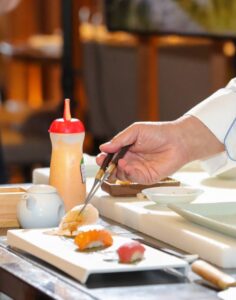
“I’d like to show you how to eat sushi,” said Matsuhisa.
“A lot of people put a lot of soy sauce and mix wasabi with the soy sauce, right?”
That’s not Matsuhisa’s way. “Of course you can use chopsticks but I recommend that you eat with your fingers. Touch the sushi, turn it halfway to the side, dip the fish side into the soy sauce and then eat it in one bite. This is the best way to eat sushi.”
He said, “Soy sauce has a lot of sodium. If you dip the rice side in your soy sauce, the rice will vacuum the soy sauce… That’s a lot of sodium. It’s not good for your body.”
There’s already wasabi in the nigiri, but you can add more if you’d like, he said.
He also demonstrated how to dip the fish side of the sushi in soy sauce with chopsticks. “But I recommend that you eat sushi with your fingers. That way, you can feel more heart.”
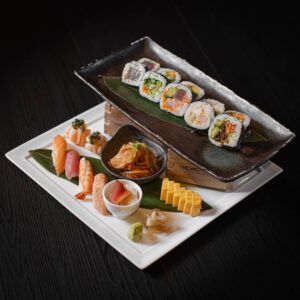
Empire
Heart is important to Matsuhisa. It’s with his service trademark kokoro—or “from the heart”—that he has grown his empire to 50 Nobu restaurants, 11 Matsuhisa restaurants, 38 Nobu Hotels, and 12 residence projects across the world, with more under development.
“Nobu is not just me—it’s also my team. I have strong teams who I have spent years working with and educating personally. They go out and teach everyone my philosophy for good food and good service, so we are all working toward the same goal. I also spend most of the year traveling to visit my teams and am constantly reinforcing my philosophy. We are very hands-on, and because of that our quality and standards are consistent,” he told Lifestyle.
He added, “My biggest motivation has always been my guests’ smiling faces. I want to continue to create food and experiences that people enjoy.”
Matsuhisa was only 17 when he started working in a restaurant in his hometown of Saitama, Japan. His culinary journey took him to Peru (traces of which can still be seen in his food today—like his ribeye yakimono with anticucho sauce), and then Anchorage, Alaska, where he experienced the darkest time of his life.
Fifty days after he opened his restaurant there, it burned down. He thought about ending it all, he said. “It was my wife and daughters who helped me through that time. After that, I have always tried to keep going, even just a millimeter forward. I learned patience and to never give up.”
In 1987, he opened Matsuhisa in Los Angeles, and it became hugely popular with celebrities. That’s how he met Robert De Niro, who would eventually become his partner in opening Nobu. It took De Niro years to convince Matsuhisa to open a New York restaurant with him and Meir Teper.
Of course, that first Nobu was just the beginning. Not only has his empire grown, but over the years, he’s also received many awards and accolades, including a number of Michelin Stars. Today, Matsuhisa’s food and brand of hospitality can be enjoyed in cities all over the world including Manila.
He told Lifestyle, “The past 10 years with Nobu Manila have been incredible. When we opened, I was excited to bring Nobu to the Philippines, a country with such a rich culinary heritage and a deep love for fresh seafood. It has been amazing to see how guests in Manila have connected with us. I am very grateful for my team here.”








